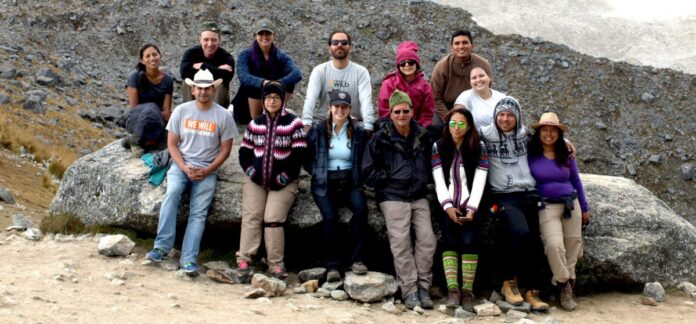BY Vicky Brito
You need a certain amount of attitude to weather the altitude.
UTRGV art students found that out first hand this summer, when they trekked high into the Peruvian Andes to visit the famed Inca ruins of Machu Picchu.
Dr. Robert Bradley, UTRGV associate professor of Art, accompanied 10 students to Peru from May 18 to May 31, hiking to Machu Picchu as part of a two-week study abroad course, “Hiking the Inca Trail.”
“It’s really pretty rigorous,” said Bradley, who was hiking this trail for the first time. “It’s a lot of altitude and I thought, ‘Well, could we all do it?’”
But the students, both undergraduate and graduate students, were definitely interested.
“They came up with a program for physical conditioning before we actually went on the four-day trek,” he said. “We had no problems.”
The course syllabus stipulated that the students would keep a daily journal detailing their observations about the country’s pre-Columbian art and architecture, along with the environmental setting.
They hiked a classic Inca Trail, called the Salcantay Route, which climbs to 4,600 meters above sea level, or 15,200 feet. That’s 700 feet higher than the summit of Mount Whitney, the highest peak in the contiguous United States.
Preparations began at Cusco – which is 10,000 feet above sea level and the second-lowest point of the trek – to give the group a chance to acclimatize, Bradley said.
During the first of eight conditioning hikes, the group enjoyed the ancient Inca stonework around the town of Pisac.
The second hike took the group into Ollantaytambo, an Inca royal estate.
“One of my mentors told me years ago, the best way you can understand pre-Colombian people is to walk the trails that they walked and walk the Inca road networks that they walked, because they did this without horses or mules or anything like that,” Bradley said. “This is the best way to really appreciate it.”
The conditioning needed for this trek is both physical and mental, he said, and stressed to students that putting their mind to the hike would be key.
“You can do a lot of things that you think you can’t do, it’s just a matter of training and wanting to do it,” Bradley said. “I think that is what is really wonderful about these trips. You are using your mind to understand the pre-Colombian world, but you’re also using your body. I was super happy with the success.”
STUDENTS’ REACTIONS
David Ortiz, a senior biology major, said this trek helped him understand a different culture’s traditions and history.
“Visiting the ancient ruins was really exciting,” he said. “It also helped improve my Spanish skills by being immersed in it.”
He said the hike felt “normal” because of the physical conditioning they put in before the undertaking.
“When we completed the hike, it felt amazing and the view was spectacular,” Ortiz said.
Junior art major Carla Reimer said each day of this study abroad trip was an adventure and credited the trip with influencing her artwork.
“I am inspired to do more and work harder because I know that it is possible,” Reimer said. “To see the incredible accomplishments of the Incas, and even the accomplishments of my peers and I as we hiked, makes me realize that we are so much more than the limitations we put on ourselves.”
Reimer said the Salkantay Trek pushed her emotionally, physically, spiritually and mentally.
“There were times when I was breathing perfectly fine, then the heights, combined with going down steps, would almost paralyze me with fear,” she said. “Yes, there was some physical pain, but it was so worth it. Everywhere you looked, you wanted to try and capture the view with your camera, knowing that it would never do it justice.”
This trek was Miriam Cepeda’s third study abroad trip to Peru for her Latin American Art History courses.
“This was by far the most enjoyable and adventurous trip to the Pachamama. I highly recommend the El Salkantay Trek to the strong, and heed caution to the weak.”
Cepeda said that during the four-day hike, the group was confronted with different obstacles every day.
“Rain, cold, sleet, rocks, clouds, darkness, stars, sweat, tears, blood and, of course, some horse poop. Expect it all when hiking this trail.
“As a team, we accomplished everything together, more than 40 miles at up to 15,000 feet of elevation. If you are seeking a boring, monotonous trip, this is not one of them.”




